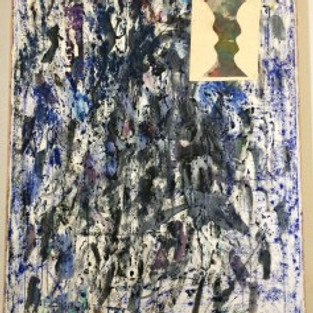
Mark Dutcher, The Prisoners at Beyond Baroque. Photo credit: Jody Zellen.
Mark Dutcher: The Prisoners
at Beyond Baroque
Through June 30th
By Jody Zellen
Following on the heels of his 2017 exhibition of abstract paintings Another World at Jason Vass Gallery, Mark Dutcher is now using Jean Genet’s 1950 film, Un Chant d’Amour, as a point of departure. Entitled The Prisoners, this show of new paintings is accompanied by poems by Maw Shein Win and Adrian de la Pena. In his or her own way, each investigates ideas about relationships, intimacy and voyeurism as raised in Genet’s film which was set in a French prison. The primary element in Dutcher’s canvases is the ubiquitous figure-ground vase illusion. Centered in each painting is the curvilinear form of an abstracted vase flanked by what appears to be two heads in silhouette. These figures are meant to reference two prisoners in adjacent cells. The heads try to communicate across this painted barrier. Never touching, yet longing for connection, they share similar features as represented by Dutcher’s use of gold and silver leaf, glitter and impastoed brush strokes.
Because Dutcher presents the same compositional elements in each painting, the viewer is required to look closely at the nuances and differences in the works. Each anonymous face has a distinct silhouette and is depicted as a monochromatic entity with or without a medley of interlocking shapes in varying colors. Dutcher has a purposely casual painting style that is gestural and expressionistic, verging on messy. That being said, these aggressively painted works are infused with a sense of urgency. As the viewer’s focus fluctuates between seeing the figure and the ground, they can reflect on myriad personal and universal struggles.
In addition to numerous small and mid-sized paintings, Dutcher also presents a series of works on paper. These oil and paint stick pieces— Prisoners (Querelle)— reference Genet’s novel Querelle of Brest (published in 1947) and illustrated by Jean Cocteau. Querelle of Brest is about a bisexual thief who kills his lovers for thrills and profit. In Dutcher’s series, the silhouetted vase/face or faces occupied a small area in an otherwise scribbled ground which signs for both the sea and the landscape where the action in the novel takes place. This tumultuous atmosphere is represented through Dutcher’s worked surfaces.
Dutcher uses both Querelle of Brest and Un Chant d’Amour as a metaphor for past and present struggles and denied freedom— be it homosexuals alive during Genet’s times, or the others of today—immigrants, undocumented workers, or the LGBTQ population.
#losangeles #california #art #painting #losangelesart #contemporaryart #MawSheinWin #southerncalifornia #abstract #BeyondBaroque #artgallery #gallery #artandcake #artopening #markdutcher #assemblage #artexhibition #installation #ArtandCakeLA #artists #artist #AdriandelaPena #mixedmedia #arts #artmagazine #ArtandCulture #exhibition #theprisoners






















